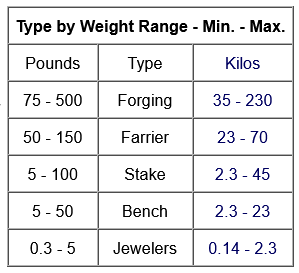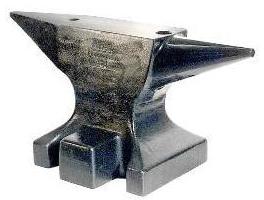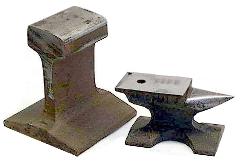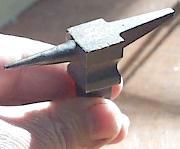Selecting an Anvil
Which is right for you?
Jock Dempsey – anvilfire.com
The best anvils are made of selectively hardened tool steel with a well balanced attractive shape and various useful working surfaces. It has taken centuries to develop the shapes of anvils and similar to the violin some anvil styles were perfected long ago and will probably never change.
Types of Anvil
As with most tools there is a lot of overlap in application. A forging anvil or general shop anvil can also be used for making horse shoes and light forging can be done on a farrier’s anvil. A heavy sheet metal stake can be used for light forging and bench work. Small bench work anvils can be used for jewelry but are clumsy for delicate work. However it is impossible to forge anything larger than fine wire on a little 5 oz. (150g) jewelers anvil and difficult to use a large 200 pound (90kg) forging anvil for jewelry work. Each task is best performed using the proper size tool.
The size of the anvil should be proportional to the work and the hammer used to perform that work. For forging an average hand hammer to anvil ratio of about 50:1 is normal. Example, a heavy 4 pound (1800g) hammer and a 200 pound (90kg) anvil are a good match.

Forging anvils
The first decision to make when selecting a forging anvil is the size or weight. In general you want the heaviest anvil you can afford but there are other factors. Do you need portability? Do you need to move your anvil to the job or from storage to work space? 100 to 150 pound (45 to 70 kg) anvils are the most commonly found old anvil because they are the largest convenient portable size. The scale of your work is also a factor. If you know that most of your work is going to be light forging of 1/2″ (13mm) stock or less or heavy sheet metal then a small anvil between 75 and 125 pounds is a good choice.


Cast iron anvils are popularly called an ASO for “Anvil Shaped Object”. These “anvils” are cheap junk largely being imported from China. They are soft, brittle and will chip or break under normal use. They are not suitable for any extended use other than as a door stop.
Style varies somewhat among different brands of forging anvil. The difference between single horned with a wide rectangular heel and double horn with a tapering square is largely a matter of taste or what you are used to. The short waistless Italian style Nimba and Texas Farrier Supply anvils look odd to many but are good forging anvil designs.
Farriers anvils

Stake anvils


Bench anvils

Jewelers anvils

References and Links
anvilfire Gallery of Anvils Anvils from all over the world.
Finding Anvils Looking for old, used, cheap or free anvils? Here is how to do it.
My First Anvil A true story by Jock Dempsey
Anvil Series
- Types and Specifications
- Index to anvil making articles
- Buying used anvils
- Quality, welding and other anvil miscelania
- Anvil Radiuses – Grinding corners
- Testing Anvil Rebound
- Weight of Anvils
- Cast Steel vs. Forgings
- Styles and Preferences
- About Hardie Holes Updated with data table.
- Anvil Stands from the iForge page
